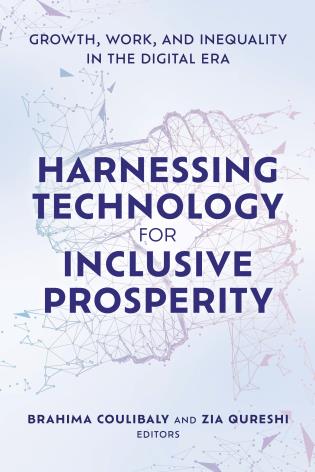Ours is a time of transformative technological change. Advances in digital technologies have been reshaping economies—and societies. And the latest innovations in artificial intelligence (AI) can take the ongoing technological transformation to a whole new level.
The new technologies open exciting new possibilities. They create new opportunities and avenues to boost economic prosperity and human welfare. Their potential to lift productivity and economic growth is considerable. But they also pose new challenges and risks. As today’s technologies drive change, they can deepen economic and social fault lines. There is uneven participation in the new opportunities created by the digital transformation. Many are being left behind, across industries and the workforce. Economic inequality has been on the rise in many economies.
Rising inequality and related disparities and anxieties have been fomenting societal discontent, political polarization, and populist nationalism. An increasingly unequal society can weaken trust in public institutions and undermine democratic governance. Mounting global disparities can imperil geopolitical stability. Managing technological transformation in ways that foster its benefits, contain risks, and build inclusive prosperity is a major public policy challenge of our time.
Against this background, a new book, “Harnessing Technology for Inclusive Prosperity: Growth, Work, and Inequality in the Digital Era,” seeks to promote ideas and actions to manage digital transformation and the latest advances in AI with foresight and purpose to shape a more prosperous and inclusive future. The book, which we had the privilege to co-edit, includes contributions from scholars from Brookings, academia, and institutions from different regions of the world who bring unique perspectives and expertise to the multifaceted challenges posed by the complex interplay of technology, growth, work, and inequality.
The new technologies have been altering market dynamics in ways that tend to increase inequality—between firms and between workers. Firms at the technological frontier have pulled away from the rest, acquiring dominance in increasingly concentrated markets and raking in supernormal profits (and rents). Increasing automation of low- to middle-skill jobs has shifted labor demand toward higher-level skills, hurting wages and jobs at the lower end of the skill spectrum. With the new technologies favoring capital, winner-take-all business outcomes, and higher-level skills, the distribution of both capital and labor income has been turning more unequal, and income has been shifting from labor to capital. These dynamics have been more evident in advanced economies but could increasingly impact developing economies as the new technologies make deeper inroads there.
How will AI, the next phase of the digital revolution, affect the relative demand for skills and earnings inequality? There is still much uncertainty as to how the scope of AI capabilities may evolve. As AI advances, displacement risks could affect some higher-level skills as well, in contrast to the previous waves of automation. However, the displacement risk at higher skill levels may apply more at the task level than at the level of entire jobs or occupations as has been the case with low- to middle-level skills. Higher-skilled workers typically also have greater ability to adjust by gaining new skills and new employment than do less-skilled workers.
It is not only that inequality has been rising. The expected productivity dividend from digital technologies has not fully materialized. While these technologies make productivity measurement more complex, data show that productivity growth has slowed rather than accelerated in many economies. Firms leading the charge on the new technologies have captured the lion’s share of the returns. Productivity growth in these firms—the big tech—has been strong, but it has stagnated or slowed in most other, smaller firms, weighing down aggregate productivity growth. Technological diffusion across firms has been weak.
Absent countervailing policies, the current high levels of inequality may persist or increase further. Even as new waves of innovations increase productivity and produce greater economic affluence, and as new jobs and tasks emerge to replace those displaced and prevent large technological unemployment, inequality could reach much higher levels. Continuing and large increases in inequality may not be a sustainable path considering associated social and political risks. A lesson of history is that large and unchecked increases in inequality can end up badly for society.
In contrast to rising within-country inequality, inequality between countries has been falling in recent decades. Faster-growing emerging economies have been narrowing per capita income gaps relative to advanced economies. Technological change, however, poses new challenges for this global economic convergence. Manufacturing-led growth in emerging economies has been propelled by their comparative advantage in labor-intensive products based on large supplies of low-skilled, low-wage workers. This source of comparative advantage increasingly will erode with expanding automation of low-skilled work, disrupting traditional pathways to development.
Challenges for public policy
Large and persistent increases in inequality are not an inevitable consequence of technological progress. The history of past major technological breakthroughs tells us that policy choices matter greatly to whether technology serves the interests of a few or becomes the foundation for more widespread prosperity. Technology has the potential to be a catalyst for shared prosperity. The challenge lies in harnessing it to promote inclusive growth and development.
Public policy in general has been slow to rise to the challenge. Policies have lagged shifting growth and distribution dynamics as technology has reshaped markets, business models, and the nature of work. The result has been both a failure to capture the full productivity potential of the new technologies and a failure to counteract some of their consequences that increase inequality. With more responsive policies, better outcomes are possible.
The digital economy must be broadened to disseminate new technologies and productive opportunities to wider segments of firms and workers. This will both help avert rising inequality and capture the productivity dividend from digital transformation across wider swaths of the economy. Combating inequality as technology drives change, therefore, is not only a distributional issue; it is also a growth issue. The paths to harnessing new technologies to achieve stronger and more inclusive economic growth are closely interlinked.
The policy agenda, as detailed in the new book, is broad, spanning competition policy and regulatory frameworks, research and development policies, digital access, education and training, labor market policies and social protection, and taxation. The agenda goes well beyond redistribution—that discussions on combating inequality often narrowly focus on—and encompasses a range of “predistribution” policies to make markets and economic growth, as they are reshaped by technology, more inclusive.
More research, fresh thinking, and experimentation will be needed in many of these areas of reform considering the profound technology-driven changes in the functioning of markets and economies. Adapting to new technologies is a big challenge for policymakers. But that is not the only challenge. A related challenge is to shape technological change itself so that it supports broader economic and social goals rather than the interests of narrow groups of investors.
As technology alters patterns of international comparative advantage, it can potentially slow global economic convergence. But as it disrupts some traditional pathways to growth and development, it also offers new opportunities for developing economies that successfully adapt their growth models to the changing economic paradigm. These range from leapfrogging opportunities in development opened by the new technologies to greatly increased international connectivity to new areas of comparative advantage going beyond traditional manufacturing and encompassing services that technology is making increasingly tradable across borders.
Much of the above policy agenda lies at the national level, but there are important new challenges at the international level as well. Not only must past gains in establishing a rules-based multilateral system for trade and investment be shielded from today’s increased protectionist pressures and resurgent nationalist industrial policies, but new rules and disciplines must be devised for globalization that is going increasingly digital. In particular, international cooperation in the governance of powerful emerging technologies, notably AI, will be important in realizing their benefits while managing risks. Greater international cooperation may seem daunting in the current geopolitical environment, but it is essential to harnessing technological progress for the benefit of all.





Commentary
Turning technology into a catalyst for shared prosperity
July 11, 2024